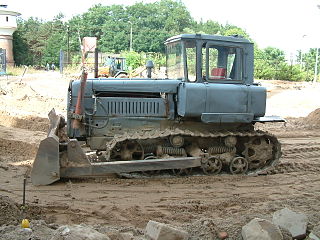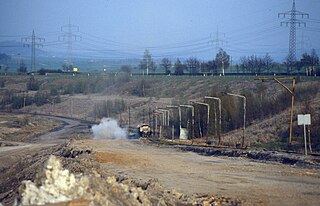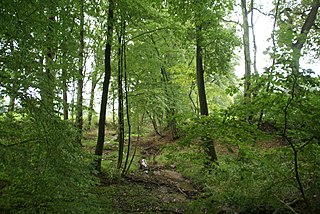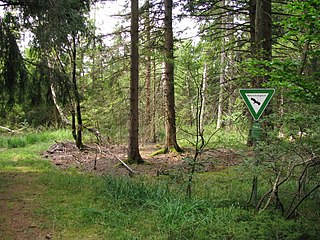Renaturation can mean:
- Renaturation, in biochemistry, the reversal of the process of denaturation
- Ecological restoration, also sometimes called renaturization
Renaturation can mean:

In biochemistry, denaturation is a process in which proteins or nucleic acids lose the quaternary structure, tertiary structure, and secondary structure which is present in their native state, by application of some external stress or compound, such as a strong acid or base, a concentrated inorganic salt, an organic solvent, agitation and radiation, or heat. If proteins in a living cell are denatured, this results in disruption of cell activity and possibly cell death. Protein denaturation is also a consequence of cell death. Denatured proteins can exhibit a wide range of characteristics, from conformational change and loss of solubility or dissociation of cofactors to aggregation due to the exposure of hydrophobic groups. The loss of solubility as a result of denaturation is called coagulation. Denatured proteins lose their 3D structure, and therefore, cannot function.

The Lippe is a river in North Rhine-Westphalia, Germany. It is a right tributary of the Rhine and 220.3 km (136.9 mi) in length with an elevation difference of 125 metres and a catchment area of 4.890 km². The source is located at the edge of the Teutoburg Forest in Bad Lippspringe close to the city of Paderborn. It runs westward through Paderborn, Lippstadt and then along the northern edge of the Ruhr area, parallel to the river Emscher and river Ruhr. The river finally enters the Rhine at Wesel.

Land development is the alteration of landscape in any number of ways such as:
Inclusion bodies are aggregates of specific types of protein found in neurons, and a number of tissue cells including red blood cells, bacteria, viruses, and plants. Inclusion bodies of aggregations of multiple proteins are also found in muscle cells affected by inclusion body myositis and hereditary inclusion body myopathy.

The Emscher is a river, a tributary of the Rhine, that flows through the Ruhr area in North Rhine-Westphalia in western Germany. Its overall length is 83 kilometres (52 mi) with an mean outflow near the mouth into the lower Rhine of 16 m3/s (570 cu ft/s).

Twist is a municipality in the Emsland district, in Lower Saxony, Germany. It is situated directly on the Dutch border.

Ellerbek is a municipality in the district of Pinneberg in Schleswig-Holstein in Germany. It consists of the two parts, Ellerbek-Dorf and Neu-Ellerbek.

The Selz is a river in Rhineland-Palatinate, Germany, and a left hand tributary of the Rhine. It flows through the largest German wine region, Rheinhessen.
C0t filtration, or CF, is a technique that uses the principles of DNA renaturation kinetics (i.e. Cot analysis) to separate the repetitive DNA sequences that dominate many eukaryotic genomes from "gene-rich" single/low-copy sequences. This allows DNA sequencing to concentrate on the parts of the genome that are most informative and interesting.
C0t analysis, a technique based on the principles of DNA reassociation kinetics, is a biochemical technique that measures how much repetitive DNA is in a DNA sample such as a genome. It is used to study genome structure and organization and has also been used to simplify the sequencing of genomes that contain large amounts of repetitive sequence.

Ribonuclease T1 (EC 4.6.1.24, guanyloribonuclease, Aspergillus oryzae ribonuclease, RNase N1, RNase N2, ribonuclease N3, ribonuclease U1, ribonuclease F1, ribonuclease Ch, ribonuclease PP1, ribonuclease SA, RNase F1, ribonuclease C2, binase, RNase Sa, guanyl-specific RNase, RNase G, RNase T1, ribonuclease guaninenucleotido-2'-transferase (cyclizing), ribonuclease N3, ribonuclease N1) is a fungal endonuclease that cleaves single-stranded RNA after guanine residues, i.e., on their 3' end; the most commonly studied form of this enzyme is the version found in the mold Aspergillus oryzae. Owing to its specificity for guanine, RNase T1 is often used to digest denatured RNA prior to sequencing. Similar to other ribonucleases such as barnase and RNase A, ribonuclease T1 has been popular for folding studies.
Fusobacterium polymorphum is a subspecies strain of the anaerobic, Gram-negative bacterium, Fusobacterium nucleatum. Originally, it was isolated from the plaque samples of individuals diagnosed with periodontitis and has been phylogenetically identified as its own distinct sub-group, separate from its previously studied sister strains. Research studies have also linked this subspecies to human diseases, such as fatal sepsis and inflammatory periodontal disease.

Tropomyosin alpha-1 chain is a protein that in humans is encoded by the TPM1 gene. This gene is a member of the tropomyosin (Tm) family of highly conserved, widely distributed actin-binding proteins involved in the contractile system of striated and smooth muscles and the cytoskeleton of non-muscle cells.

Gombeth is a constituent community of Borken and had its first documentary mention in 857 as "Gumbetta die Marka". Once an independent community, it was amalgamated with Borken in 1974. Gombeth is surrounded on all sides by former open-pit brown coal mines, being found to the south, towards Singlis, and towards Borken. The pit east of Gombeth was filled in by PreussenElektra as part of the renaturation programme.

The LASSELSBERGER Group is an international producer of raw materials, building materials and tiles based in Pöchlarn. Both local home markets and international markets - especially in Western Europe - are supplied from the production sites in Central and Eastern Europe. The subsidiaries of the three divisions Ceramics, Building Materials and Minerals as well as the local organizations are managed and coordinated from Pöchlarn. The term "LASSELSBERGER Group" represents the umbrella term for all corporate components of Lasselsberger GmbH.

Brunnbach is a small river of Bavaria, Germany. It is about 3 kilometres (1.9 mi) long and flows through the district Bogenhausen in Munich. It is a right tributary of the Isar.
In ecology, potential natural vegetation (PNV), also known as Kuchler potential vegetation, is the vegetation that would be expected given environmental constraints without human intervention or a hazard event.
Denaturing High Performance Liquid Chromatography (DHPLC) is a method of chromatography for the detection of base substitutions, small deletions or insertions in the DNA. Thanks to its speed and high resolution, this method is particularly useful for finding polymorphisms in DNA.

The Furtbek is a stream in Hamburg in the outer north-east of the city.

Wildmoos Nature Reserve is a protected area located in the municipality of Gilching in the Starnberg District, Bavaria. It is also part of the Western Part of Starnberg District landscape conservation area and "Moors and Beech Forests between Etterschlag and Fürstenfeldbruck" Natura 2000 site.